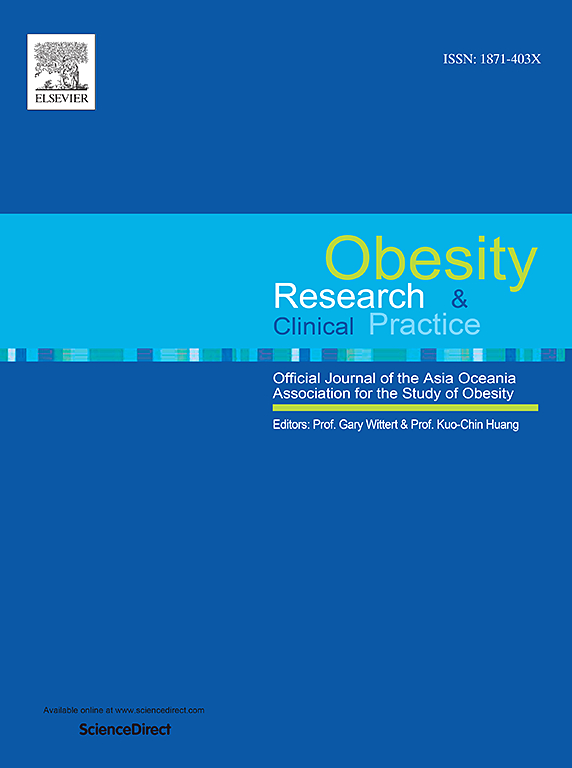参与达到最佳健康(GIRTH):一项以社区为基础,以同伴为主导的男性生活方式改变计划-一项准随机试验
IF 2.5
4区 医学
Q3 ENDOCRINOLOGY & METABOLISM
引用次数: 0
摘要
在以社区为基础的生活方式改变项目(LMP)中,男性的代表性不足。进行了一项准随机试验,以评估GIRTH(一项以同伴为主导、以组为基础的男性LMP)在降低心脏代谢危险因素方面的疗效。11组178名男性(平均年龄58 岁,腰围110 厘米)被按1:3的比例分配给只接受健康生活方式信息的对照组(n = 45)和每周参加12次面对面会议的GIRTH组(n = 133),重点是健康素养、目标设定、问题解决和自我监控。主要观察指标为腰围(WC)在12周内的变化。次要结局包括身体质量指数(BMI)、血压、握力、血脂和血糖、饮食、身体活动、饮食、运动、应对和睡眠自我效能评分的变化。对照组和GIRTH组的保留率分别为68 %和88 %。WC两组降低(p & lt; 0.001),但在周长减少更大集团(意向处理:−4.2 厘米−−3.3 vs 5.1−1.9 厘米,3.1−−0.7;p = 0.002;as-treated:−5.3 厘米−−4.4 vs 6.1−3.0 厘米,4.6−−1;p = 0.009)。两组男性在体重、身体质量指数、血压、应对、睡眠和饮食调节、自我效能评分以及身体活动方面均有改善(p <; 0.05)。GIRTH组的男性在高密度脂蛋白(HDL)、甘油三酯(TC)/HDL比值和运动自我效能评分方面也有改善(p <; 0.05)。WC的减少与体重、BMI、收缩压、血脂以及水果和蔬菜摄入量的增加相关(p <; 0.05)。在降低男性WC和心脏代谢疾病危险因素方面,GIRTH项目比单独的信息更有效。本文章由计算机程序翻译,如有差异,请以英文原文为准。
Get Involved Reach Top Health (GIRTH): A community-based, peer-led group lifestyle modification program for men – A quasi-randomised trial
Men are underrepresented in community-based lifestyle modification programs (LMP). A quasi-randomised trial was undertaken to assess the efficacy of GIRTH, a peer-led, group-based LMP for men, in reducing cardiometabolic risk factors. One-hundred-seventy-eight men (mean age 58 yrs, waist circumference 110 cm) in 11 groups, were allocated 1:3 to either a control group receiving healthy lifestyle information only (n = 45) or a GIRTH group involving 12, weekly, face-to-face sessions focused on health literacy, goal setting, problem solving and self-monitoring (n = 133). The primary outcome was waist circumference (WC) change over 12-weeks. Secondary outcomes included changes in body mass index (BMI), blood pressure, grip strength, lipid profile and glucose, diet, physical activity, and diet, exercise, coping, and sleep self-efficacy scores. The retention was 68 % and 88 % for the control and GIRTH groups respectively. WC decreased in both groups (p < 0.001), but the decrease was greater in the GIRTH group (intention-to-treat: −4.2 cm, −5.1 to −3.3 vs −1.9 cm, −3.1 to −0.7; p = 0.002; as-treated: −5.3 cm, −6.1 to −4.4 vs −3.0 cm, −4.6 to −1; p = 0.009). Men in both groups had improvements in weight, BMI, blood pressure, in coping, sleep and regulate eating self-efficacy scores, and physical activity (p < 0.05). Men in the GIRTH group also had improvements in high density lipoprotein (HDL), triglyceride (TC)/HDL ratio, and exercise self-efficacy score (p < 0.05). Reduction in WC correlated with changes in weight, BMI, systolic blood pressure, lipids, and increased fruit and vegetable consumption (p < 0.05). The GIRTH program was more effective than information alone in reducing WC and cardiometabolic disease risk factors in men.
求助全文
通过发布文献求助,成功后即可免费获取论文全文。
去求助
来源期刊

Obesity research & clinical practice
医学-内分泌学与代谢
CiteScore
7.10
自引率
0.00%
发文量
80
审稿时长
49 days
期刊介绍:
The aim of Obesity Research & Clinical Practice (ORCP) is to publish high quality clinical and basic research relating to the epidemiology, mechanism, complications and treatment of obesity and the complication of obesity. Studies relating to the Asia Oceania region are particularly welcome, given the increasing burden of obesity in Asia Pacific, compounded by specific regional population-based and genetic issues, and the devastating personal and economic consequences. The journal aims to expose health care practitioners, clinical researchers, basic scientists, epidemiologists, and public health officials in the region to all areas of obesity research and practice. In addition to original research the ORCP publishes reviews, patient reports, short communications, and letters to the editor (including comments on published papers). The proceedings and abstracts of the Annual Meeting of the Asia Oceania Association for the Study of Obesity is published as a supplement each year.
 求助内容:
求助内容: 应助结果提醒方式:
应助结果提醒方式:


